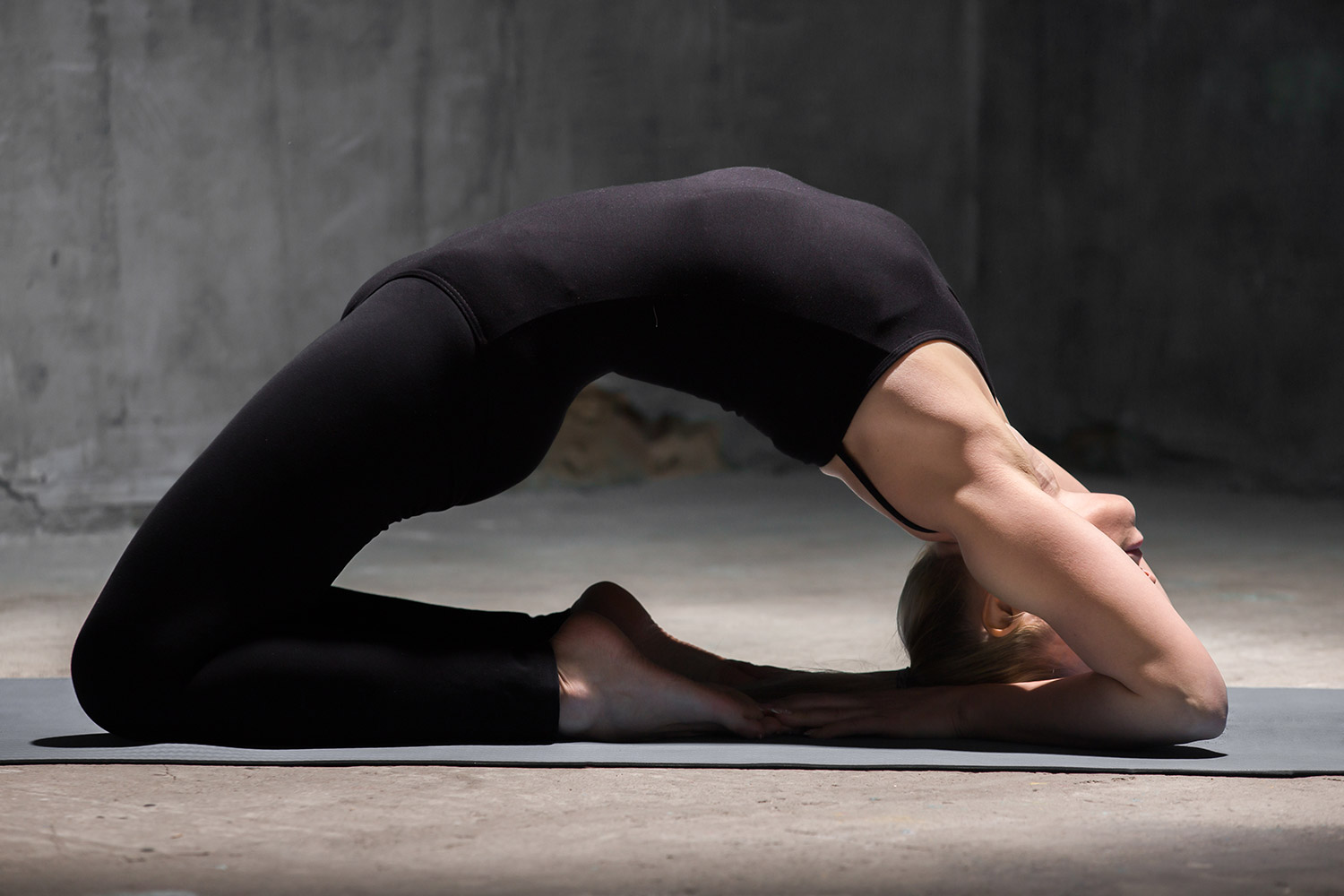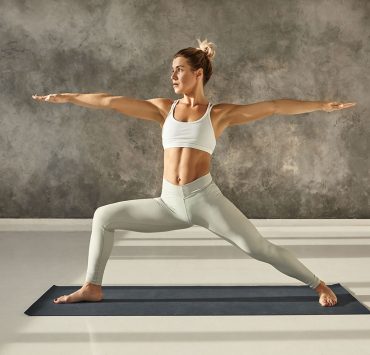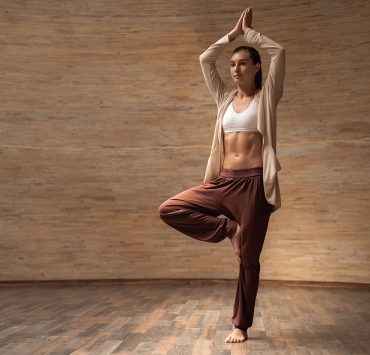
Susan views the world through a lens of spirituality, health,…
The asana requires coordination of various muscle groups which you must be aware of to keep the pose safe and proper preparation must be practiced before you try adding Kapotanasana to your regular yoga asana routine.
Kapotanasana is actually the final form of the Kapotanasana series which are a progression of asana with deeper back bends and hip openers:
- Ardha Kapotanasana (Half Pigeon Pose)
- Raja Kapotanasana (King Pigeon Pose)
- Eka Pada Raja Kapotanasana (One-Legged King Pigeon Pose)
- Eka Pada Raja Kapotanasana II (One-Legged King Pigeon Pose 2)
It is said that back bends help us stay in the moment by allowing us to face our fears. As an inversion, Kapotanasana also helps us to see the world from a different perspective. And because it is also a deep heart opener, Pigeon Pose allows us to open up to trust and feel freedom – just like a pigeon is free to fly wherever it pleases.
Say it in Sanskrit – Eka Pada Raja Kapotanasana

The name of this pose is taken from two Sanskrit words which can be translated directly into English:
Kapota – Pigeon
Asana – Pose
Kapotanasana literally means Pigeon Pose. While the obvious name of this pose comes from the way the chest pushes forward, just like a pigeon puffs its chest, the word “kapota” is also the name of a sage.
Kapota was mentioned in the epic poem Mahabharata and the Kalika Puruna. He was said to have no match in power, vigor, strength, vitality, and agility. People called him the son of Garuda (a mighty bird which was the vehicle of Lord Vishnu) because wherever he walked, it seemed like his feet never touched the ground.
It was written that even the sons of Lord Shiva, Bhairava and Vetal, came to him for guidance and counsel because of his wisdom and clarity.
Some believe that practicing Kapotanasana and other progressions to this most advanced variation of Pigeon Pose, one will reach the same level as the sage Kapota.
Benefits of Pigeon Pose

Because Kapotanasana is such a deep back bend, it strengthens your back muscles while also stretching the entire front body.
All major areas of your body get expanded and activated in this asana from your ankles, thighs, groin, abdomen, chest, shoulders, arms, and throat.
On an energetic or subtle body anatomy level, Kapotanasana activates all seven chakras, but the ones that get the most focus are Anahata, or the Heart Chakra, and Sahasrara, or the Crown Chakra.
In addition, practicing back bends help to improve posture and spinal health, and help to stimulate your internal organs.
Kapotanasana, just like the other progressions of Pigeon Poses, is also a hip opener which stretches the deep hip flexors and improves hip mobility.
Contra-indications for Pigeon Pose

Although there are many benefits to Kapotanasana, certain yoga practitioners should avoid or postpone adding this asana to their practice.
As an advance posture, it should only be attempted with the guidance of a trained expert who respects your limits and will help you to recognize and respect your body’s present condition too.
If you have had an injury to your spine, shoulders, or neck, check in with your doctor or physical therapist before trying Pigeon Pose.
Kapotanasana is a back bend and it is also considered an inversion. Traditionally, people with the following conditions should take precautions if they want to practice these types of asana:
- Stiff or sore back
- Hypertension
- Blood Pressure Issues
- Migraines
- Insomnia
- Spondylitis (Inflammation of the vertebrae)
- Breathing difficulties
- Pregnant
- Menstruating
- Depression
If you feel pain in your shoulders or lumbar spine at any time you practice this pose, back off. The asana should feel like a deep stretch through long, deep, steady breaths. Kapotanasana may look challenging, but when practiced with proper preparation, should never feel painful.
Step-by-Step Guide How to Get into Pigeon Pose

There are two ways to get into Kapotanasana as described by BKS Iyengar in his book, Light on Yoga.
For either version, always warm up sufficiently before going into a deep back bend. Some suggested asana to prepare are detailed later.
Steps for beginner yoga practitioners:
- Start in Vajrasana (Diamond Pose aka Thunderbolt Pose).
- Begin to recline backwards and use your arms for support as you lower your trunk backwards into Supta Vajrasana. Be aware of your hip mobility. Do not force your body to lower if pain arises, especially in your knees. If you are able to lower your back completely onto the ground, release your hands and arms for the next step.
- Bring your hands on the floor on both sides of your head. Your fingers should point towards your shoulders. Your palms should be placed near your ears just above your shoulders.
- Straighten and stretch your arms to bring your body weight towards your palms. At the same time, lift your body above your knees. You will feel the stretch in your thighs. Join your feet to together.
- Bend your elbows to bring your forearms onto the ground. Reach for your feet and place your hands on your toes or hold on to your heels.
- Engage your thigh muscles and raise your pelvic floor a bit more. Carefully bring your head towards your feet and place the crown of your head on the soles of your feet.
To Release:
Always keep your breath long and deep throughout the asana. To release Kapotanasana, release your hand grip from your feet and remove the contact of your head from your feet. Slide your elbows forward to lift your forearms from the ground and slowly lower your body back down to Supta Vajrasana.
Roll onto one side then the other to release your folded legs one at a time and lay in Savasana (Corpse Pose).
Steps for intermediate to advance yoga practitioners.
- Start in Ustrasana (Camel Pose). You may keep your hands on your back or behind your head instead of reaching for your heels.
- Engage your core and push your hips forward for more support as you reach your arms up, and back.
- Continue reaching back and squeeze your buttocks for more support as you extend your spine. Allow your bank bend to deepen until your palms reach the floor into Kapotanasana B.
- Working one arm at a time, walk your right hand towards your feet and grip your right heel. Transfer your weight into your right hand and leverage it on your heel to help press up and move your left hand towards your left foot. In the same way, grip your left heel with your left hand. Squeeze your elbows and push your hip forward for more support.
- Exhale and bend your elbows so that your forearms come onto the ground. Carefully place your head on your feet.
To Release:
Release the grip on our feet and continue squeezing your buttocks and pushing your hips forward to support your back. On an exhale, straighten your arms and slowly push up and bring your body forward. Engage your core to help lift and come to a high kneeling position.
Rest in Balasana (Child’s Pose) or Savasana.
Variations of Pigeon Pose

The base pose of Kapotanasana is Ustrasana (Camel Pose) which is a good option to “level down” the pose if you can’t quite lower your body to rest your elbows on the ground yet. Any of the variations for Ustrasana are also good substitutions or preparatory asana for Pigeon Pose later on in your practice.
Another option if your backbend is already more developed is Kapotanasana B (Pigeon Pose B) which is the same as Kapotanasana except you keep your arms extended and place your palms on the ground behind you instead of your elbows and forearms.
If you feel like some support could help you gain more confidence in practicing this asana, you can do Kapotanasana on a Chair. Metal folding chairs that are usually made for Chair Yoga practices are the safest, but you may also use any stable chair with a flat seat. Place a cushion on the chair so it will be more comfortable on your back.
Sit facing backwards in the chair. Your legs will go through the opening at the back of the chair. Bend your legs and squeeze the back legs of the chair for support. Carefully lower your body into the back bend, draping yourself on the chair. Reach your arms up and back to hold your feet or the two front legs of the chair.
Prep Poses to Warm-up for Kapotanasana

Salambha Bhujangasana (Sphynx Pose) – This passive backbend will help warm up your spine.
Matsyendrasana (Lord of the Fishes Pose / Seated Twists) – These twists will not only help with spine mobility, they help open up the hips and shoulders, and keep your abs supple yet strong.
Gomukhasana (Cow Face Pose) – This seated asana helps improve hip mobility, opens up your shoulders, and stretches your arms.
Anjaneyasana (Lunge Pose) – Lunges will help strengthen your legs and core, and target your quads which also need to stretch and warm up before going into deep back bends.
Virasana and Supta Virasana (Hero and Reclined Hero Pose) – These poses will help you assess your hip mobility while improving it, and also helps stretch the quad and adductor muscles.
Anahatasana (Heart Melting Pose aka Extended Puppy Pose) – This pose combines a passive backbend with a shoulder opener.
Setu Bhanda Sarvangasana (Bridge Pose) – This foundational back bend asana helps prepare you for deeper back bends and will help you identify the pushing motion needed for your hips and the squeezing action for your knees that are needed for Kapotanasana.
Chakrasana (Wheel Pose) – This asana is one of the deepest of the beginner level back bends and helps your get confident in being upside down.
Salamba Sirsasana (Headstand) – The pushing action of your elbows into the floor to keep yourself balanced in this asana is similar to what you will need to do when you go into the full expression of Pigeon Pose.
Ustrasana (Camel Pose) – This is the pose you start off with in the advance entry into Kapotanasana.
Follow-up Poses to Pigeon Pose:

Practice asana that will release and relieve your spine and hips.
Adho Mukha Svanasana (Downward Facing Dog) – This pose will counter the deep back bend and stretch your legs, sacrum, spine, and arms.
Supta Parivritta Garudasana (Reclining Eagle Spinal Twist) – These twists help to release your spine, hips, and shoulders.
Balasana (Child’s Pose) – This recovery pose will help to relax your spine and release and tension left over from the intense asana.
Savasana (Corpse Pose) – This final asana is a good way to end a yoga practice. It allows you to completely reap the benefits of yoga and get into a space of calm and surrender.
Meditate in Sukhasana (Easy Seated Pose) – It would be good to get into the habit of meditating for a few minutes after a yoga asana practice. The asanas are just the physical practice of yoga which help prepare your body for meditation.
Conclusion

Kapotanasana is one of the most challenging yoga asana for any level of yoga practitioner. But with a regular and dedicated practice, it is attainable.
Start slow and with full awareness, respect, and mindfulness of where your body and head are at. The pose should never feel forced or painful. With proper preparation, Pigeon Pose will simply feel like a deeper full body stretch.
The sage Kapota was revered for being a full package of wisdom and strength. It’s no wonder that this pose, which requires both strength and understanding of your body and the muscle groups that need to coordinate to express this asana, was named after him.
What's Your Reaction?
Susan views the world through a lens of spirituality, health, and compassion. Her positive outlook on life shines through her writing, which is heavily focused on yogic living, meditation, and conscious eating.














